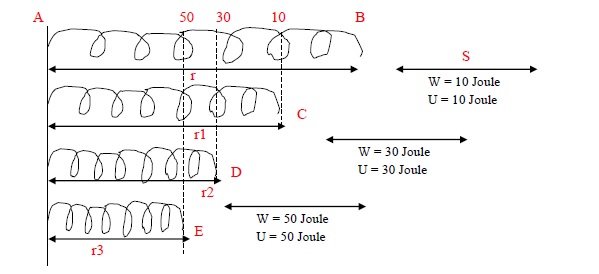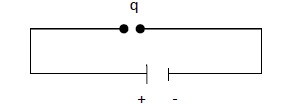Potential Energy of a Charge in Electric Field
Description:
Let there be a charge ‘Q’ creating an electric field all around it. Two points A and B are located on the electric field, such that points A and B are at a distance rA and rB respectively from the charge Q. Where rB < rA. As shown in fig. we know that potential decreases as the distance from charge ‘Q’ increases. So, potential at B will be stronger than potential at A.
Potential VB= 1 q4πε0 rB
VA= 1 q4πε0 rB
Work done to carry a charge from infinity to a point gives the potential of that point. So potential is an indication of a location.

For example
Consider a spring having length ‘r’ as shown in figure. Let the spring is so pressed at one of its end, that the length of the spring remains the same. It means that, the work done on the spring was not sufficient to change its length.
When the force( F) is applied in the spring and is compressed, the spring also exerts a force opposite to the applied force . To reduce the length of the spring, the external applied force is needed to be greater than opposing force exerted by the spring.

On applying greater force at the end of the spring, let the length of the spring gets reduced from ‘r’ to ‘r1’. It means that the spring dot displaced from point B to C. Let S be the displacement of the spring from its original length and the work done be 10 joule.
So, work done (W) on the spring = F* S. =10 joule.
It means that the spring has acquired 10 joule of energy.
Now let 30 joul of work is done on the spring, so that the spring got displaced further from point C to D. Once after removing the external force, the spring acquires 30 joule of energy
let 50 joul of work is done on the spring, so that the spring got displaced further from point D to E. Once after removing the external force, the spring acquires 50 joule of energy.
Mark all these values on the scale attached with the original spring.
This marking is an indication of a point which tells about the amount of energy stored in the spring at every point on compression.
When the spring was compressed to point B, it acquired 10 joule of energy.
When compressed to point C, it acquired 30 joule of energy and so on.
Note −
- Energy is stored when work is done on the spring.
- Position marked on the scale is the potential at that point in volt.
Similarly, if we put our figure carrying free charges at the terminal of say 12 volt battery, the charges will acquire 12 joule of energy from the battery. This energy will tend to flow to earth, but because of the high resistance of body, charges do not flow.

But if we put our figure carrying free charges in the socket carrying potential = 240 v, the charges will acquire 240 joule of energy from the socket. This large energy is sufficient to make charge flow from the body to earth, hence giving a shock.
Similarly −
A holder carries potential of 240 volt. When the bulb carrying free charges is put in the holder, the electric charges acquire 240 joule per unit charge of energy from electricity and bulb begin to glow. Even though the holder carries potential, no energy flows unless a charge is taken to a location which has got a potential.
Note −
Energy is always carried out by charge placed at the terminal of battery.
Battery or a socket is an indicator that it carries potential not potential energy.
Potential at a point is an indicator of a location which tells about the amount of energy acquired by a charge on doing a particular amount of work on it.

